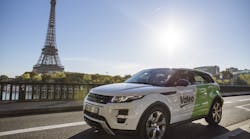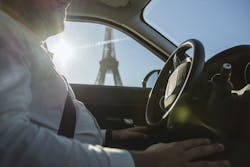If you have ever been to Paris, Rome, or even New York City, you know the roads are either curvy, difficult to drive with traffic, or full of people. One of the most difficult things to manage is the unpredictability of it all. This is one of the main reasons that self-driving vehicles have avoided major city areas and have tested their cars in more remote locations. However, this year’s Paris Motor Show changed all that: Valeo demonstrated its new autonomous car, the first time a self-driving car has ever been tested on the streets of Paris.
Valeo’s car is equipped with a series of sensors specially developed by the company. These includes ultrasonic sensors, cameras, radars, and eight Valeo SCALA laser scanners—a proprietary system which is the only mass-produced Light Detection and Ranging (LiDAR) technology on the market today developed specifically Valeo cars. All of the data collected go into the car’s artificial intelligence system to help it learn different driving scenarios over time.
The AI system can collect the data from the sensors and analyze them in real time. This enables the car to make the correct driving decisions, despite the surrounding conditions. According to Valeo, “The vehicle’s self-learning capabilities, based on deep learning, play a fundamental role. For example, the vehicle can:
- Display a 3D model of surrounding vehicles and predict their trajectories, including those not in its immediate field of vision;
- Navigate in a precise and robust manner, thanks to a geolocation and mapping system developed by Valeo, which uses the Valeo SCALA® laser scanners that are already being series produced. This enables the vehicle to drive without human intervention through tunnels, in parking garages, and in other environments where a GPS signal would be lost;
- Learn about the road infrastructure, in real time and with every trip, to handle”
The vehicle has an autonomy level of 4 and can handle driving along an undivided highway, smart and traditional traffic lights (stop and start) and road signs, intersections and traffic circles, and other road users (pedestrians, bicycles, scooters).
Along with a fleet of self-driving cars and electric vehicles, Valeo offers driver assistance safety systems to help reduce accidents.
Valeo is also demonstrating is electric vehicle (EV) lineup. The manufacturer has developed an EV urban prototype powered by a 48 V motor. The car can reach up to 100 km/h (62 mph) with a range of 150 km (93 miles). This is an important push as many countries around Europe are demanding an all-electric vehicle fleet by 2020 or 2025. The company also debuted its first plug-in hybrid at the low voltage of 48 V. This would make it the world’s first 48 V plug-in and has a range of 40 km (25 miles). The combustion engine would take over the vehicle once the battery has been depleted.
Along with autonomous vehicles and EVs, Valeo debuted its tools for inside the car to help passengers with their commute. First is the Safe InSight safety monitoring system. The system can detect signs of drowsiness from the driver and help prevent accidents due to tiredness.
Valeo has also developed digital tools to help drivers. For example, they provide a real-time map of air quality in Paris. The onboard sensors can collect data on the air quality in its environment. The sensors are able to collect information on the concentration levels of six pollutants: fine particles (PM 10 and PM 2.5), carbon monoxide, nitrogen dioxide, sulfur dioxide and ozone. The data is then transmitted into the cloud for air quality mapping.
The mapping is being conducted in partnership with ARIA and in the future can help drivers avoid certain areas that are experience peak pollution spikes. Valeo offers a “Clean Road” app that can determine the best route in terms of air quality. It calculates the number of kilometers to be traveled and how the air quality along the way will impact travel time. With this toolset, EVs, and self-driving cars, Valeo is setting itself up to be a major player in the future of smart automotive.


